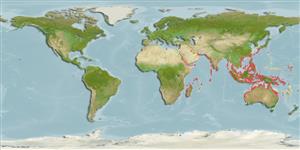>
Eupercaria/misc (Various families in series Eupercaria) >
Labridae (Wrasses) > Corinae
Etymology: Stethojulis: Greek, stetho, stethion = brest; literal = to prick a little breast + Greek, ioulis, a fish dealing with genera Coris or Thalassoma (Ref. 45335).
More on author: Bleeker.
Environment: milieu / climate zone / depth range / distribution range
Ecología
marino asociado a arrecife; rango de profundidad ? - 18 m (Ref. 90102). Tropical; 35°N - 33°S, 32°E - 168°E
Indo-West Pacific: Persian Gulf (Ref.80050); Red Sea and East Africa to Papua New Guinea, south to Lord Howe Island. Unknown from Micronesia.
Tamaño / Peso / Age
Maturity: Lm ? range ? - ? cm
Max length : 15.6 cm TL macho / no sexado; (Ref. 26587)
Espinas dorsales (total): 9; Radios blandos dorsales (total): 11; Espinas anales 3; Radios blandos anales: 11. True form has interrupted mid-lateral stripe. Female with yellow stripe from the tip of snout to just past axil, running below eye where pale silvery-blue; male with continuous mid-lateral line and dark 'ear' (Ref. 48636).
Coastal to outer reef crests. In Japan, it is found in areas of mixed sand, rock and coral (Ref. 9710). Occurs in small groups to about 20 m depth (Ref. 48636). Feeds by sorting small animals from mouthfuls of sand and detritus.
Life cycle and mating behavior
Madurez | Reproducción | Puesta | Huevos | Fecundidad | Larva
Oviparous, distinct pairing during breeding (Ref. 205).
Randall, J.E., 2000. Revision of the Indo-Pacific labrid fishes of the genus Stethojulis, with descriptions of two new species. Indo-Pac. Fish. (31):42 p. (Ref. 36378)
IUCN Red List Status (Ref. 130435)
Threat to humans
Harmless
Human uses
Pesquerías: sin interés; Acuario: Comercial
Más información
ReferenciasAcuiculturaPerfil de acuiculturaRazasGenéticaElectrophoresesheritabilidadEnfermedadesProcesamientoNutrientsMass conversion
Herramientas
Special reports
Download XML
Fuentes de Internet
Estimates based on models
Preferred temperature (Ref.
123201): 24.3 - 29.2, mean 28.4 °C (based on 2808 cells).
Phylogenetic diversity index (Ref.
82804): PD
50 = 0.5010 [Uniqueness, from 0.5 = low to 2.0 = high].
Bayesian length-weight: a=0.00977 (0.00548 - 0.01741), b=3.07 (2.92 - 3.22), in cm total length, based on LWR estimates for this species & Genus-body shape (Ref.
93245).
Nivel trófico (Ref.
69278): 3.4 ±0.3 se; based on diet studies.
Resiliencia (Ref.
120179): Alto, población duplicada en un tiempo mínimo inferior a 15 meses (Preliminary K or Fecundity.).
Fishing Vulnerability (Ref.
59153): Low vulnerability (10 of 100).
Nutrients (Ref.
124155): Calcium = 101 [60, 174] mg/100g; Iron = 0.771 [0.443, 1.442] mg/100g; Protein = 18.5 [15.6, 20.7] %; Omega3 = 0.152 [0.096, 0.245] g/100g; Selenium = 20.8 [12.1, 38.4] μg/100g; VitaminA = 150 [46, 547] μg/100g; Zinc = 1.85 [1.26, 2.92] mg/100g (wet weight);
